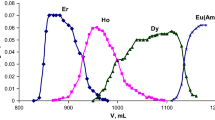Summary
Coprecipitation of traces of cobalt, zinc, chromium, ruthenium and mercury with freshly precipitated aluminium hydroxide has been investigated by a radiotracer method. Investigations were performed over a wide range of pH. The results indicate that traces of cobalt, zinc and chromium could be almost completely coprecipitated between pH 6 and 10. On the other hand coprecipitation yield for ruthenium in this pH range do not exceed 95%, which is believed to be the consequence of the various physicochemical states of ruthenium. The coprecipitation yields for mercury are very low as a consequence of the presence of non-ionized HgCl2.
Zusammenfassung
Die Mitfällung von Spuren Kobalt, Zink, Chrom, Ruthenium und Quecksilber mit frisch gefälltem Aluminiumhydroxid wurde radiochemisch untersucht. Die dazu nötigen Experimente erstreckten sich über ein weites pH-Gebiet. Die Ergebnisse zeigen, daß Spuren Kobalt, Zink und Chrom zwischen pH 6 und 10 fast vollständig mitgefällt werden konnten. Andrerseits sind die Mitfällungsausbeuten für Ruthenium in diesem pH-Gebiet nicht größer als 95%, was vermutlich die Folge der verschiedenen physikalischchemischen Zustände des Rutheniums ist. Die Mitfällungsausbeuten für Queckilber sind infolge der nur geringen Dissoziation des HgCl2 sehr gering.
Similar content being viewed by others
References
I. Bačić, N. Radaković andP. Strohal, Analyt. Chim. Acta54, 149 (1971).
R. A. Lauderdale, Ind. Eng. Chem.43, 1538 (1951).
C. A. Amphlett, Treatment and Disposal of Radioactive Wastes, New York: Pergamon Press. 1961.
A. K. Lavrukhina, T. V. Malisheva andF. I. Pavlockaja, Radiochimiceskij Analiz (Radiochemical Analysis), Akademia Nauk USSR, Moskva 1963.
J. H. Sullivan andJ. E. Singley, J. Amer. Water Works Assoc.60, 1280 (1968).
J. D. Hem, Aluminium Species in Water; in: Trace Inorganics in Water (R. F. Gould, editor), Amer. Chem. Soc., Advances in Chemistry Series No. 73, Washington, D. C. 1968. pp. 98–114.
A. Ohyoshi, E. Ohyoshi, M. Senoo andM. Shinagawa, J. Nucl. Sci. Technol.3, 237 (1966).
Lj. Marazović andZ. Pučar, J. Chromatography27, 450 (1967).
L. G. Sillén, The Physical Chemistry of Sea Water; in: Oceanography, Amer. Assoc. Advancement of Science, Washington, D. C. 1961. pp. 549–581.
E. D. Goldberg, The Ocean as a Chemical System; in: The Sea, Vol. 2, New York: Interscience. 1963. pp. 3–25.



